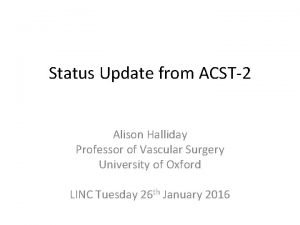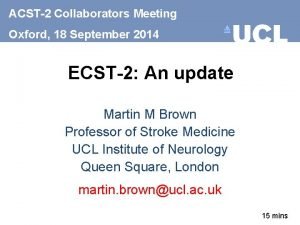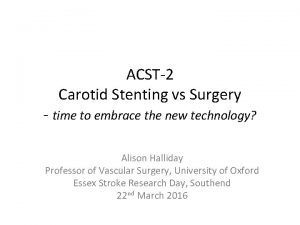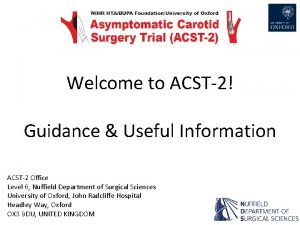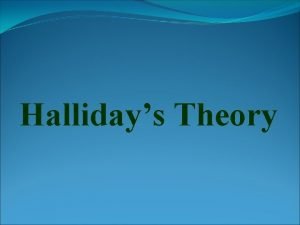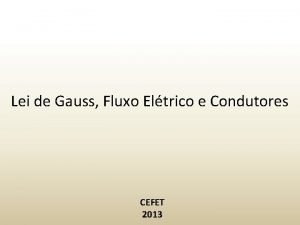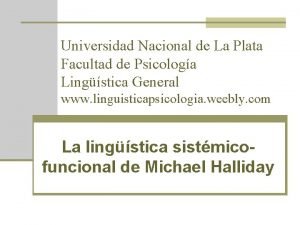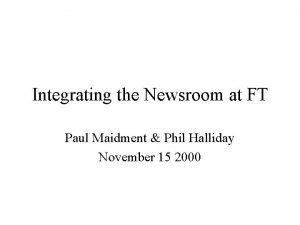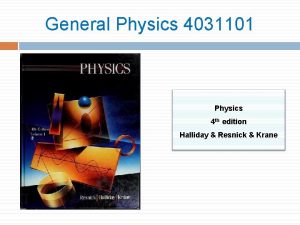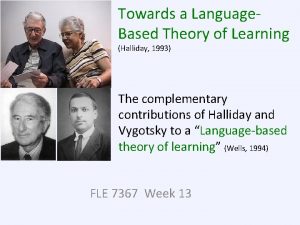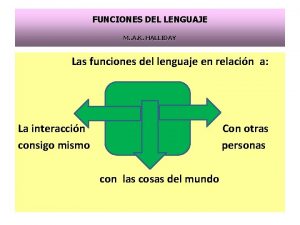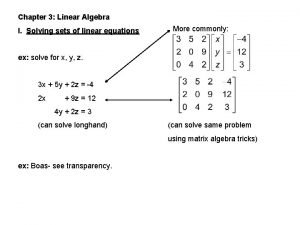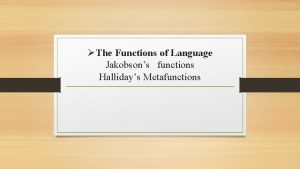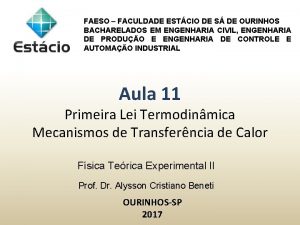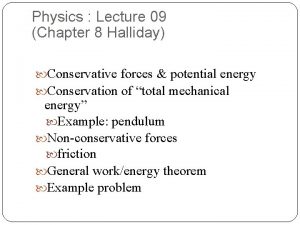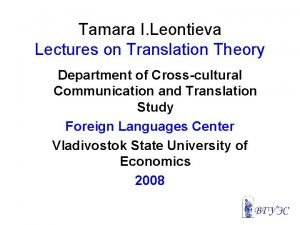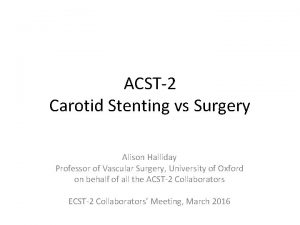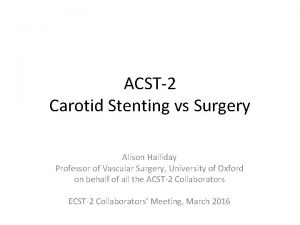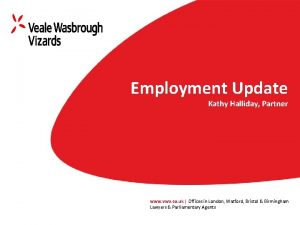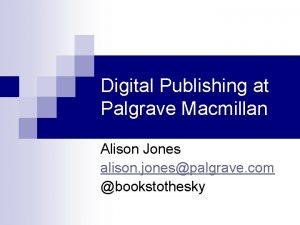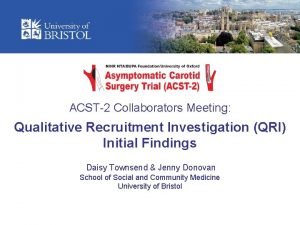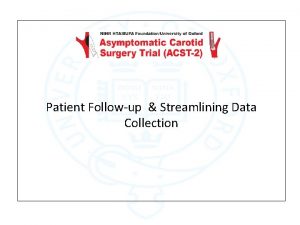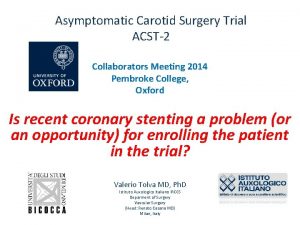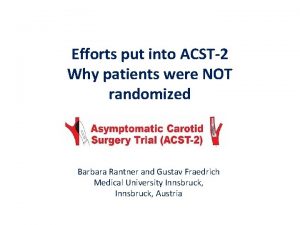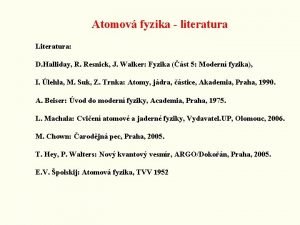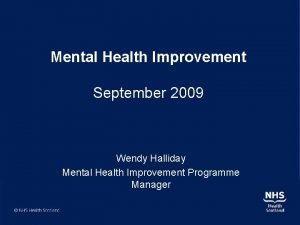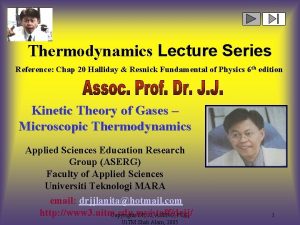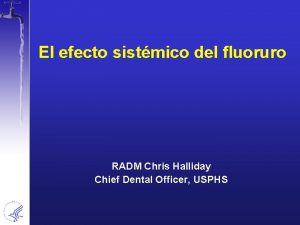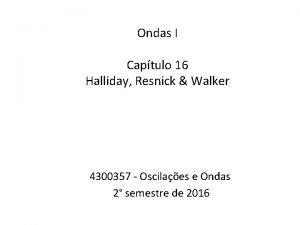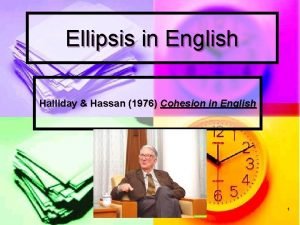Status Update from ACST2 Alison Halliday Professor of

























- Slides: 25

Status Update from ACST-2 Alison Halliday Professor of Vascular Surgery University of Oxford LINC Tuesday 26 th January 2016

Disclosure Alison Halliday I have no potential conflicts of interest to report:

15 -20% ischaemic Strokes are caused by carotid stenosis

ACST-1 Rationale of ACST-2 – followed from our first ACST-1 trial (1993 -2008)

Asymptomatic carotid artery stenosis: narrowing that has not yet caused a stroke Might intervention prevent stroke?

ACST-1: CEA reduces 10 -year stroke risk by 6 -7%

With statins - same absolute benefit from surgery

ACST-1 – peri-operative risk reduced by statin therapy ACST-1 4. 3% 2. 2%

Better procedural outcomes for CEA and CAS

Since ACST-1: Falling risks from CEA and CAS • Reduced procedural risk for CEA (Statins) • Reduced procedural risks for CAS…

Falling risks from CEA and CAS • Reduced procedural risk for CEA (Statins) • Reduced procedural risks for CAS…

Techniques, devices, experience have all changed since the early symptomatic trials… Open vs closed-cell stent design Closed–cell safer?

Newer FLOW-reversal systems, direct puncture, membrane covered stents Reduce emboli, early results now comparable to CEA

ACT-1 Abbott-funded (Xact + Emboshield), 3 CAS : 1 CEA (88% of 1658 patients enrolled; stopped because slow) 5 year outcomes (88% alive) Any stroke Ipsi- stroke (non-procedural) Any clinical re-intervention 6% CAS vs 5% CEA 2. 2% CAS vs 2. 7% 1. 6% CAS vs 3. 3% (p=0. 05) Conclusions : Lower enrollment reduced power but CAS is non-inferior to CEA up to 1 year, with similar 5 -year results, and lower re-intervention rates

ACST-2 Status Update

Treatment for asymptomatic carotid artery stenosis: surgery or stenting?

ACST-2: Overview • First patient randomised: 2008 • Some patients are now in their 8 th year of follow up • 113 Centres in 30 countries

ACST-2 Recruitment last year at LINC 1800 1600 1400 1200 1000 800 600 400 200 0 1694

ACST-2 Surgery vs Stenting Target 3600 patients 2061 today

ACST-2: CEA vs CAS Sex, Age, Co-morbidities: Men Mean age Ischaemic heart disease Diabetic Renal impairment 70% 69 years 36% 30% 6% Stroke risk factors: Atrial Fibrillation 6% Age >75 yrs 26% Previous stroke symptoms or infarct 43%

ACST-2: medical treatments Yearly direct patient feedback (drug names and doses) At 2015 follow up Antithrombotic (aspirin, asasantin, clopidogrel, mono-dual APT, warfarin, NOAC) BP Medications (1 -3 named drugs, none) Lipid-lowering (specific drugs/doses) 96% 84% 85%

ACST-2 Stents Wallstent Cristallo Ideale Abbott Xact Cordis Precise Ev 3 Protégé® RX Abbott RX Acculink Boston Adapt Sinus Protection Devices Type Emboshield Filterwire Filter Mo. Ma Spider Accunet Angio. Guard Prox occ Filter Gore Flow Reversal Prox occ Vi. VEXX Twin One Distal balloon Roadsaver Inspire Zilver Mer Fiber. Net Viatrac Filter (87% total)

ACST-2: Open vs Endovascular treatment Blinded procedural outcomes for 1500 patients Disabling stroke/death CEA/CAS ACST-2: 1. 0% Lower than for CEA in ACST-1: 1. 7%

Recruitment plan Feb 2008 – Dec 2019

ACST-2 A very European Trial – Join us and create the future evidence! www. acst. org. uk
 Shadow paging recovery technique
Shadow paging recovery technique Acst2 trial
Acst2 trial Acst2 lancet
Acst2 lancet Acst2 lancet
Acst2 lancet Acst2 trial
Acst2 trial Promotion from associate professor to professor
Promotion from associate professor to professor Project status update examples
Project status update examples Fsu freight status update
Fsu freight status update What is sfg
What is sfg Interpretar
Interpretar Halliday
Halliday Campo tenor y modo
Campo tenor y modo Halliday
Halliday Ang kabaligtaran ng heuristiko
Ang kabaligtaran ng heuristiko Paul maidment
Paul maidment General physics halliday
General physics halliday Towards a language-based theory of learning
Towards a language-based theory of learning Halliday
Halliday Funciones del lenguaje instrumental
Funciones del lenguaje instrumental Halliday
Halliday Jakobson's functions of language
Jakobson's functions of language Halliday
Halliday Physics halliday
Physics halliday Jo halliday
Jo halliday Halliday
Halliday Dr alison landrey
Dr alison landrey

